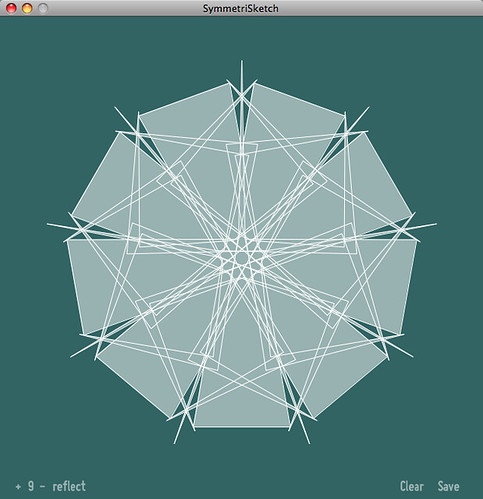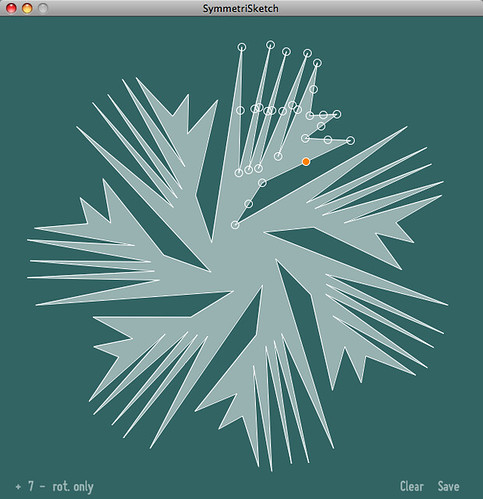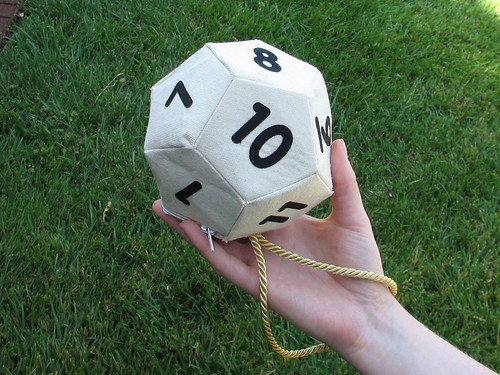- Donkey Kong shelves
- Toys for your geeky cat
- Do you actually know how toilets are made?
- If we had thermonuclear weapons, we’d set the password to um… 00000000.
- Meringue Mario Mushrooms
- The cat ladder blog has more entries than we’d expect.
- Tube Tweezers
- Hot dog sushi — Love the bun “rice”
- Winding a toroidal transformer
- Check out the portable pie chart on this page of paper based visualizations
- Edge lit card (fancy version!)
- Impressionist cakes
- The ultimate camera accessory
- If you like the geeky-crafty aspect of Evil Mad Scientist Laboratories, you’ll probably also enjoy The Domestic Scientist (“Mad Science with a Hint of Nutmeg”).
- Science teachers: Ask your students to analyze this a/c system!
All posts by Windell Oskay
Impractical idea: Iron filing nail polish
Some time ago we came across a subtle magnetic nail polish. It had fine magnetic dust in it, and could record the local magnetic field profile at the time that the polish dried.
But hey, why can’t you do this with full-on iron filings? So, for our own bold and impractical take on this concept, we tried mixing genuine iron filings with nail polish (clear, in this case). Mix well, paint on, hold finger over (large) magnet while it dries. Don’t even think about trying to fit those spiky fingertips into gloves.
Results? So-so. The particles aligned with the field and solidified, but have more clumping than we’d like to see.
Maybe slightly finer particles would have been better. Much better would be if we found a good way to work with ferrofluid that could be hardened, or perhaps a version of magnetic viewing film that could be painted onto surfaces. Or maybe, if our version above were redone with RTV silicone, the particles could wiggle around in the presence of an external field.
We leave these important questions to higher minds than our own.
Wallet-size LED Resistance Calculator
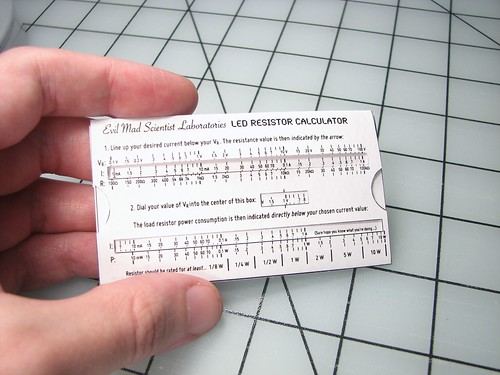
It’s like one of those online “LED resistance calculator” thingies, except that you can fold it up and put it in your wallet.
Continue reading Wallet-size LED Resistance Calculator
SymmetriSketch: A simple app for playing with symmetry
We were recently contacted by a mathematics instructor, who suggested that it might be interesting to have a program like Snowflake, but with the option of picking and choosing different symmetry properties.
Natural snowflakes have (approximate) sixfold rotation symmetry plus reflection symmetry. However, a lot of things that you can draw by hand have absolutely no resemblance to snowflakes at all– and it is somewhat fun to explicitly play with the rules.
Our new program, SymmetriSketch, sticks to the same basic design principles as Snowflake: it’s cross platform, open source, and able to export a true vector drawing with a closed path. However, SymmetriSketch is a much more flexible program that allows you to play with different symmetries, and create all kinds of different things that would never be mistaken for frozen water.
Here’s what it looks like when the program first opens:
The initial shape is an overall pentagon– an object with five-fold rotation symmetry and reflection symmetry. The figure is generated by taking the editable slice– highlighted here and when you start the program– and reflecting and rotating it to complete the full shape that you see.
Within the editable slice, you can also see three highlighted control points that can be dragged around. There is control point at every vertex and at the midpoint of every line segment between two vertices. If you drag a control point that is the midpoint of a line segment, it turns that control point into a new vertex. That new vertex also gets new control points at the midpoints to its neighbors.
Every vertex point can be moved to any location on the screen with the exception of the vertex that is initially at the top point of the pentagon– that vertex is constrained to move along the vertical axis– the axis of reflection symmetry.
The controls are purposefully kept simple. There are two symmetry controls– for the order of rotational symmetry and to toggle reflection– which you can change in the lower left hand corner of the screen.
The number, with its +/- controls, refers to the order of discrete rotational symmetry. If the number shown is n, then n-fold rotational symmetry is applied, which means that the displayed object is unchanged when rotated by 360 degrees/n. In the screenshot above, 9-fold rotational symmetry is applied.
Orders from 1 to 99 are allowed– note that 1-fold rotational symmetry is “no symmetry at all” since it requires 360/1 = 360 degrees of rotation to return to the original shape.
The second control is for reflection symmetry, and toggles between “reflect” or “rot. only,” where it either does, or does not apply a mirror reflection across the vertical axis.
With reflection symmetry turned off, the figure is drawn with pure rotational symmetry. (This screenshot was taken while editing the shape, and you can see control points, indicated by little circles.)
Continue reading SymmetriSketch: A simple app for playing with symmetry
New and improved d12 bag: How to build it
This is the set of build instructions for the updated version of our original retro-dork-chic-DIY D12 handbag.
This accompanies an article about the new version, and the d20 bag that we designed as well.
Linkdump: July 2009
- Bumper stickers for shoes
- How to identify pet rocks
- Yet another creepy meat substitute
- Don’t mess with chemists. They have water. (And Nitrogen Triiodide.)
- Kitty inbox
- Awesome Octopus
- The Algorithmic Beauty of Plants, now online.
- Earth-moon spacing
- Heavy Metal Nutcracker
- Heavy Metal Nutcracker
- Crazy MoFo goes for a bike ride
- Tapecraft!
- Arduino ISP shield
- Help Prevent Gray Goo!
- Negative temperatures: hotter than hot.
- Krispy Mitosis
Version 1.1 of the ‘2313 board
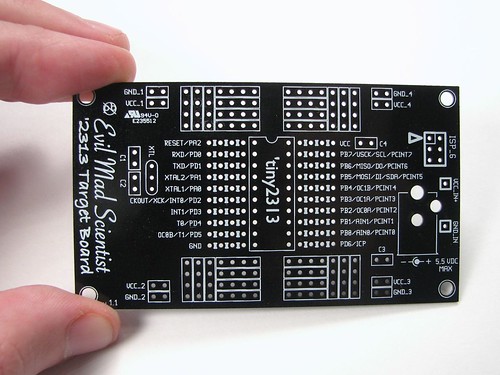
We’ve just revved our open-source ATtiny2313 breakout boards to version 1.1.
There are a couple of nice improvements for the new version. First, we made the board single sided to match our original ATmegaxx8 board– this means that it’s relatively easy to print out the layer separations and make your own at home, if you like to etch your own boards. We also changed around the configuration of the prototyping areas, making it so that you can now fit up to two DIP-8 packages, breadboard style, on the board.
Continue reading Version 1.1 of the ‘2313 board
Links on the road to TGIMBOEJ
As they sign up for the TGIMBOEJ project, we’ve been asking participants to publish a link to their web site.
Skimming through the lists, we’ve come across quite a few interesting and entertaining projects, sites, photos, and other links, both old and new.
Here are just a few of our favorites:
- DVD drive teardown
- Zezinho, the poser (interactive installation)
- A reminder of what old electronics can look like
- Also, an old Outlet Blinker
- Microcontroller controls its own power supply
- Animated jack-o-lantern
- Edge-lit robot laws
- PID on Arduino
- Command line client for Twitter
- Elmo hero
- Open-source GPIB toolkit for win32
- Silly, simple USB mug warmer
- One fine button (and some CNC stuff…)
- How to remove plastic packages from ICs
- Meggy Unboxing!
- Notes on shopping for soldering irons
- Potch’s charming home page
- The most beautiful ice-cream sandwich
- Squarecave synthesizer
- Wiring small solar cells with conductive paint
- Taxi meter clock
- Automatic cap gun
- Oscillator circuit shirt
- Hacktastic binary clock
- Theremin kit build
- A Cray-2 logic module
- Stokes’ ProjBlog
- Nixie Punk
- Symbolic math in Java
- 10x SD card
TGIMBOEJ: One year later
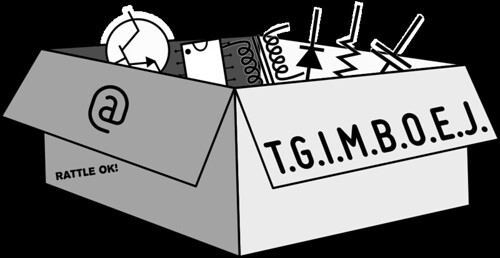
One of the big projects that we launched in 2008 is The Great Internet Migratory Box Of Electronics Junk, a pay-it-forward style hardware sharing program for electronics.
Since our original article, TGIMBOEJ (pronounced Tig-Ihm-Boh-Edge) has somewhat taken on a life of its own. In that article, we set up simple guidelines for how to pass the box along, and in the interim we have taken a “laissez-faire” approach, watching and learning from the successes and troubles with that model.
Our mostly-hands-off approach to supervising TGIMBOEJ has worked remarkably well in some respects. There are upwards of 40 circulating boxes now, which have passed through hundreds of hands. And, hundreds of other people have signed up on our wiki site tgimboej.org as potential recipients.
On the down side, the mean free path of many of the boxes has been far too short– some have made it just one hop before stopping.
In talking to folks about the boxes that got stuck, we identified three main stories (all of which point us towards fairly obvious solutions):
1: “I sent it to some guy, but I haven’t heard anything since then.”
2: “Oh yeah– I’ve been meaning to ship it for some time.”
3: “I got this box and I don’t know what to do with it.”
So now, it’s time to get serious. First, we’ve been contacting the last known recipients of the stalled boxes, and trying to get more of the existing boxes back into circulation. Second, we’re relaunching the tgimboej.org wiki site with a wholly new set of participation instructions and procedures.
To keep boxes in circulation longer, we’re now encouraging that boxes should be sent to people who have specifically requested to participate— i.e., people who are familiar with how the project works. We’ve also introduced language in the revised instructions that will guide participants to keep an eye on their box, even after it leaves their hands.
To further alleviate the potential problem of people ending up with boxes but not knowing what to do with them, we’re standardizing the printed materials that go into each new box.
Gone are the cute but scrawled little notebooks, replaced by two neat PDF forms– one to log the progress of the box, and the other with detailed instructions on how to participate.
Finally, we’re launching eight new TGIMBOEJ boxes this week, which — along with the others that are coming back into circulation — will help to increase the number and rate of box exchanges.
So now it’s your turn. If you would enjoy trading electronics with like-minded individuals, this is becoming a great time to participate in The Great Internet Migratory Box Of Electronics Junk.
To get started, please read about how it works on the TGIMBOEJ wiki, and if you’re game, add your name to the list of Box Requests.
Meggy Jr RGB Twitter Reader

We’ve turned Meggy Jr RGB into a multicolor scrolling LED twitter reader. It’s a handy external ambient data device that displays things recently written by your friends on twitter.
This project was inspired in part by the excellent Twitter LED Scroller by David Nichols. The big idea is that we use a host computer to run a Processing application, which periodically checks Twitter for updates, and then sends “scrolling” data, one column at time, to the external LED display.
Continue reading Meggy Jr RGB Twitter Reader






